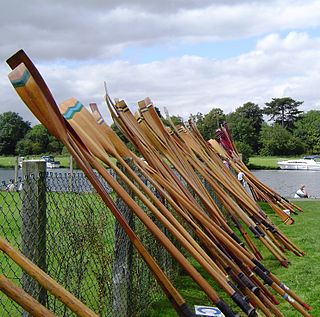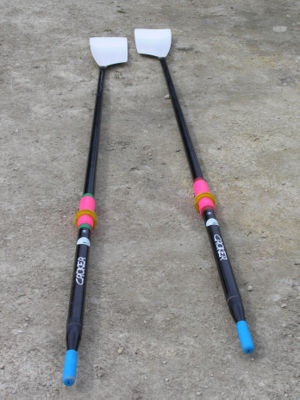
Rowing, sometimes called crew in the United States, is the sport of racing boats using oars. It differs from paddling sports in that rowing oars are attached to the boat using oarlocks, while paddles are not connected to the boat. Rowing is divided into two disciplines: sculling and sweep rowing. In sculling, each rower holds two oars—one in each hand, while in sweep rowing each rower holds one oar with both hands. There are several boat classes in which athletes may compete, ranging from single sculls, occupied by one person, to shells with eight rowers and a coxswain, called eights. There are a wide variety of course types and formats of racing, but most elite and championship level racing is conducted on calm water courses 2 kilometres (1.2 mi) long with several lanes marked using buoys.

An oar is an implement used for water-borne propulsion. Oars have a flat blade at one end. Rowers grasp the oar at the other end.

Rowing is the oldest intercollegiate sport in the United States. The first intercollegiate race was a contest between Yale and Harvard in 1852. In the 2018–19 school year, there were 2,340 male and 7,294 female collegiate rowers in Divisions I, II and III, according to the NCAA. The sport has grown since the first NCAA statistics were compiled for the 1981–82 school year, which reflected 2,053 male and 1,187 female collegiate rowers in the three divisions. Some concern has been raised that some recent female numbers are inflated by non-competing novices.

Rowing is the act of propelling a boat using the motion of oars in the water by displacing water to propel the boat forward. Rowing and paddling are similar. However, rowing requires oars to have a mechanical connection with the boat, while paddles are hand-held and have no mechanical connection.

Newington College is a multi-campus independent Uniting Church single-sex and co-educational early learning, primary and secondary day and boarding school for boys, located in Stanmore, an inner-western suburb of Sydney, New South Wales, Australia. Established in 1863 at Newington House, Silverwater, the college celebrated its sesquicentenary in 2013. The college is open to boys of all faiths and denominations. Newington has been governed by an Act of Parliament since 1922.

In rowing, oars are used to propel the boat. Oars differ from paddles in that they use a fixed or sliding fulcrum, an oarlock or rowlock attached to the side of the boat, to transfer power from the handle to the blade, rather than using the athlete's shoulders or hands as the pivot-point as in canoeing and kayaking.

In a rowing crew, the coxswain is the member who does not row but steers the boat and faces forward, towards the bow. The coxswain is responsible for steering the boat and coordinating the power and rhythm of the rowers. In some capacities, the coxswain is responsible for implementing the training regimen or race plan. Most coaches cannot communicate to boat/coxswain, so the coxswain is the "coach" in the boat. A coxswain is necessary in the first place because the rowers sit with their backs to the direction of travel. In most racing, coxswains may be of any gender regardless of the gender of the rowers.
Michael Dennis Morgan OAM is an Australian former national champion and Olympic medal winning rower. He was an Olympic level national coach and a highly successful schoolboy coach over his twenty-five coaching career.

Geoffrey Peter Stewart is an Australian former rower – a national champion, an U23 world champion and a three-time Olympian.
The Head of the River rowing regatta refers to two New South Wales school rowing competitions, one for boys and one for girls.

The Davis Men's Crew Club is a collegiate sports club representing the University of California, Davis in rowing. As a non-funded team, it is a member of the Western Intercollegiate Rowing Association (WIRA), whose participants are mostly of non-Pac-10 schools on the West Coast. Nationwide, the team is one of the most successful collegiate rowing club programs in the United States, making periodic appearances in the Intercollegiate Rowing Association national championships, the Eastern College Athletic Conference and, more recently, the American Collegiate Rowing Association national championships. Notable alumni include Seth Weil, who rowed in the USA men's coxless four at the 2016 Rio Olympics and who holds two world rowing championship first place titles in the men's four; as well as Carlo Facchino who holds a place in the Guinness Book of World Records for the fastest Pacific Ocean crossing from Monterey, CA to Honolulu, Hawaii with a time of 39 days, 9 hours and 56 minutes.
Richard Alexander Wearne is an Australian-born Sydney-based professional photographer. He is a former representative rower, an Olympian who won medals at three World Rowing Championships.
Duncan Seth Free is a retired Australian rower and Olympic gold medallist. He is dual Olympian and two-time world champion who represented Australia at four world rowing championships in both sculls and sweep oared boats. He was a six-time Australian national sculling champion.

Wyvern House is one of the two independent Uniting Church single-sex primary day schools for boys of Newington College, that is located at 115 Cambridge Street, Stanmore, an Inner West suburb of Sydney, New South Wales, Australia. The other primary school is located at Lindfield, on Sydney's North Shore. Both schools are commonly called preparatory schools.

James Jonathan Chapman is an Australian former national, Olympic representative and Olympic medal winning rower.
Matthew Long is an Australian former Olympian rower. He was an Australian national champion, a representative at World Championships and won a bronze medal in the coxless pair at Sydney 2000

Concept2, Inc. is an American manufacturer of rowing equipment and exercise machines that is based in Morrisville, Vermont. It is best known for its air resistance indoor rowing machines, which are considered the standard training and testing machines for competition rowers and can be found in most gyms.
Stephen Frederick Evans OAM is an Australian former national champion, world champion, dual Olympian and Olympic medal winning rower.

Reinhold Batschi OAM is a former Romanian rower and leading Australian rowing coach. He was the inaugural Head Coach of the Australian Institute of Sport's rowing program and Head Coach of the Australian Olympic rowing teams from 1980 to 2000.
Paul Francis Rowe was an Australian representative rower and elite level rowing coach. He was an eight-time Australian national champion in both sweep oared and sculling boats across both lightweight and open divisions. He was Australia's lightweight sculling representative at the 1975 World Rowing Championships. He coached scullers and crews to three Australia national title wins and to world championships and to Commonwealth and Olympic Games.











